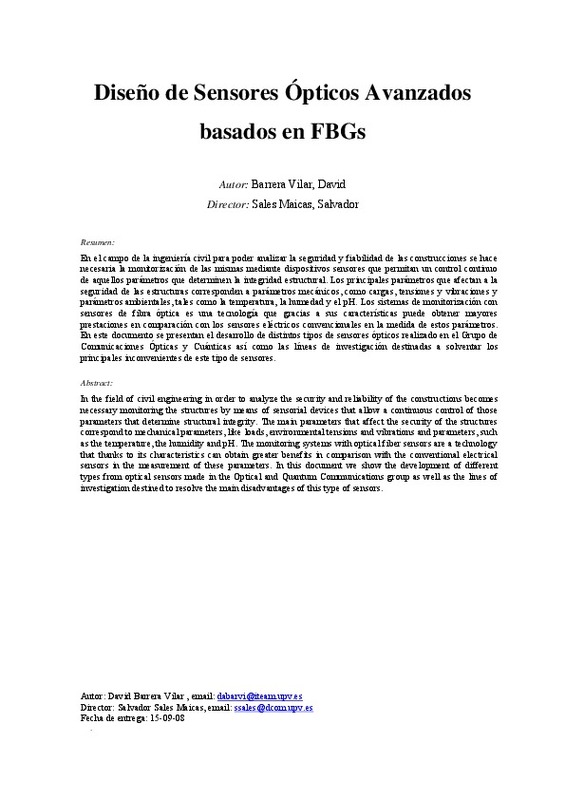JavaScript is disabled for your browser. Some features of this site may not work without it.
Buscar en RiuNet
Listar
Mi cuenta
Estadísticas
Ayuda RiuNet
Admin. UPV
Diseño de Sensores Ópticos Avanzados basados en FBGs
Mostrar el registro sencillo del ítem
Ficheros en el ítem
| dc.contributor.advisor | Sales Maicas, Salvador
|
es_ES |
| dc.contributor.author | Barrera Vilar, David
|
es_ES |
| dc.date.accessioned | 2011-10-18T09:39:37Z | |
| dc.date.available | 2011-10-18T09:39:37Z | |
| dc.date.created | 2008-09 | |
| dc.date.issued | 2011-10-18 | |
| dc.identifier.uri | http://hdl.handle.net/10251/12156 | |
| dc.description.abstract | En el campo de la ingeniería civil para poder analizar la seguridad y fiabilidad de las construcciones se hace necesaria la monitorización de las mismas mediante dispositivos sensores que permitan un control continuo de aquellos parámetros que determinen la integridad estructural. Los principales parámetros que afectan a la seguridad de las estructuras corresponden a parámetros mecánicos, como cargas, tensiones y vibraciones y parámetros ambientales, tales como la temperatura, la humedad y el pH. Los sistemas de monitorización con sensores de fibra óptica es una tecnología que gracias a sus características puede obtener mayores prestaciones en comparación con los sensores eléctricos convencionales en la medida de estos parámetros. En este documento se presentan el desarrollo de distintos tipos de sensores ópticos realizado en el Grupo de Comunicaciones Ópticas y Cuánticas así como las líneas de investigación destinadas a solventar los principales inconvenientes de este tipo de sensores. | es_ES |
| dc.description.abstract | [EN] In the field of civil engineering in order to analyze the security and reliability of the constructions becomes necessary monitoring the structures by means of sensorial devices that allow a continuous control of those parameters that determine structural integrity. The main parameters that affect the security of the structures correspond to mechanical parameters, like loads, environmental tensions and vibrations and parameters, such as the temperature, the humidity and pH. The monitoring systems with optical fiber sensors are a technology that thanks to its characteristics can obtain greater benefits in comparison with the conventional electrical sensors in the measurement of these parameters. In this document we show the development of different types from optical sensors made in the Optical and Quantum Communications group as well as the lines of investigation destined to resolve the main disadvantages of this type of sensors. | |
| dc.format.extent | 55 | es_ES |
| dc.language | Español | es_ES |
| dc.publisher | Universitat Politècnica de València | es_ES |
| dc.rights | Reserva de todos los derechos | es_ES |
| dc.subject | Sensores ópticos | es_ES |
| dc.subject | Fbg | es_ES |
| dc.subject | Deformación | es_ES |
| dc.subject | Temperatura | es_ES |
| dc.subject | Ph | es_ES |
| dc.subject.classification | TEORIA DE LA SEÑAL Y COMUNICACIONES | es_ES |
| dc.subject.other | Máster Universitario en Tecnologías, Sistemas y Redes de Comunicaciones-Màster Universitari en Tecnologies, Sistemes i Xarxes de Comunicacions | es_ES |
| dc.title | Diseño de Sensores Ópticos Avanzados basados en FBGs | es_ES |
| dc.type | Tesis de máster | es_ES |
| dc.rights.accessRights | Abierto | es_ES |
| dc.contributor.affiliation | Universitat Politècnica de València. Servicio de Alumnado - Servei d'Alumnat | es_ES |
| dc.description.bibliographicCitation | Barrera Vilar, D. (2008). Diseño de Sensores Ópticos Avanzados basados en FBGs. http://hdl.handle.net/10251/12156 | es_ES |
| dc.description.accrualMethod | Archivo delegado | es_ES |






